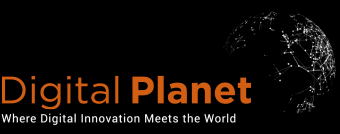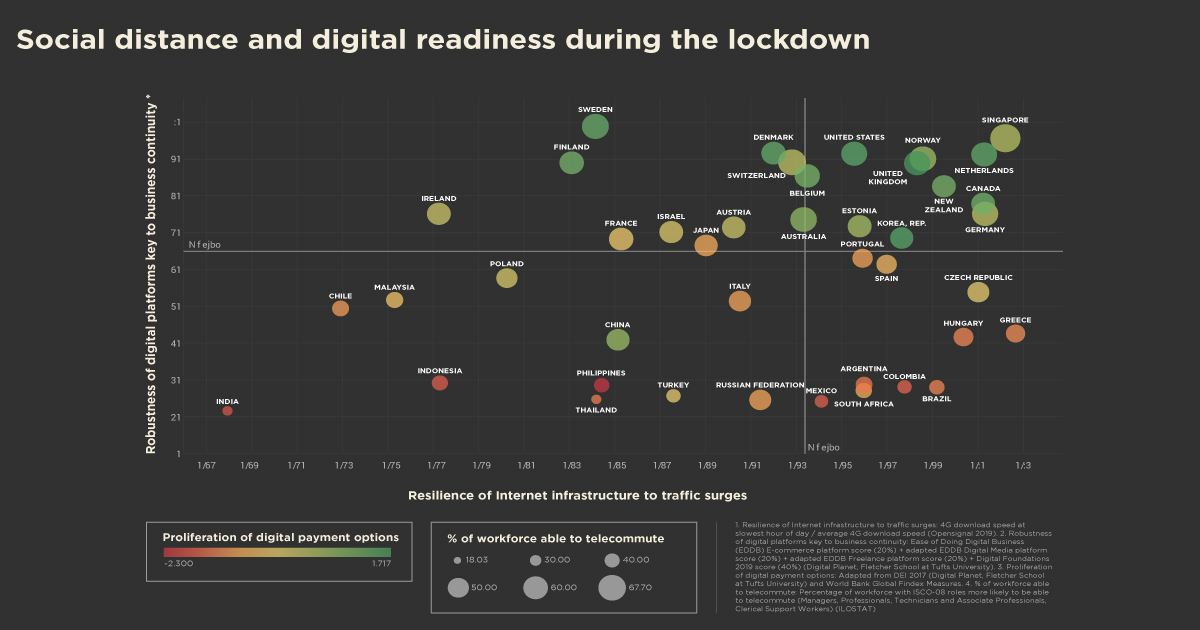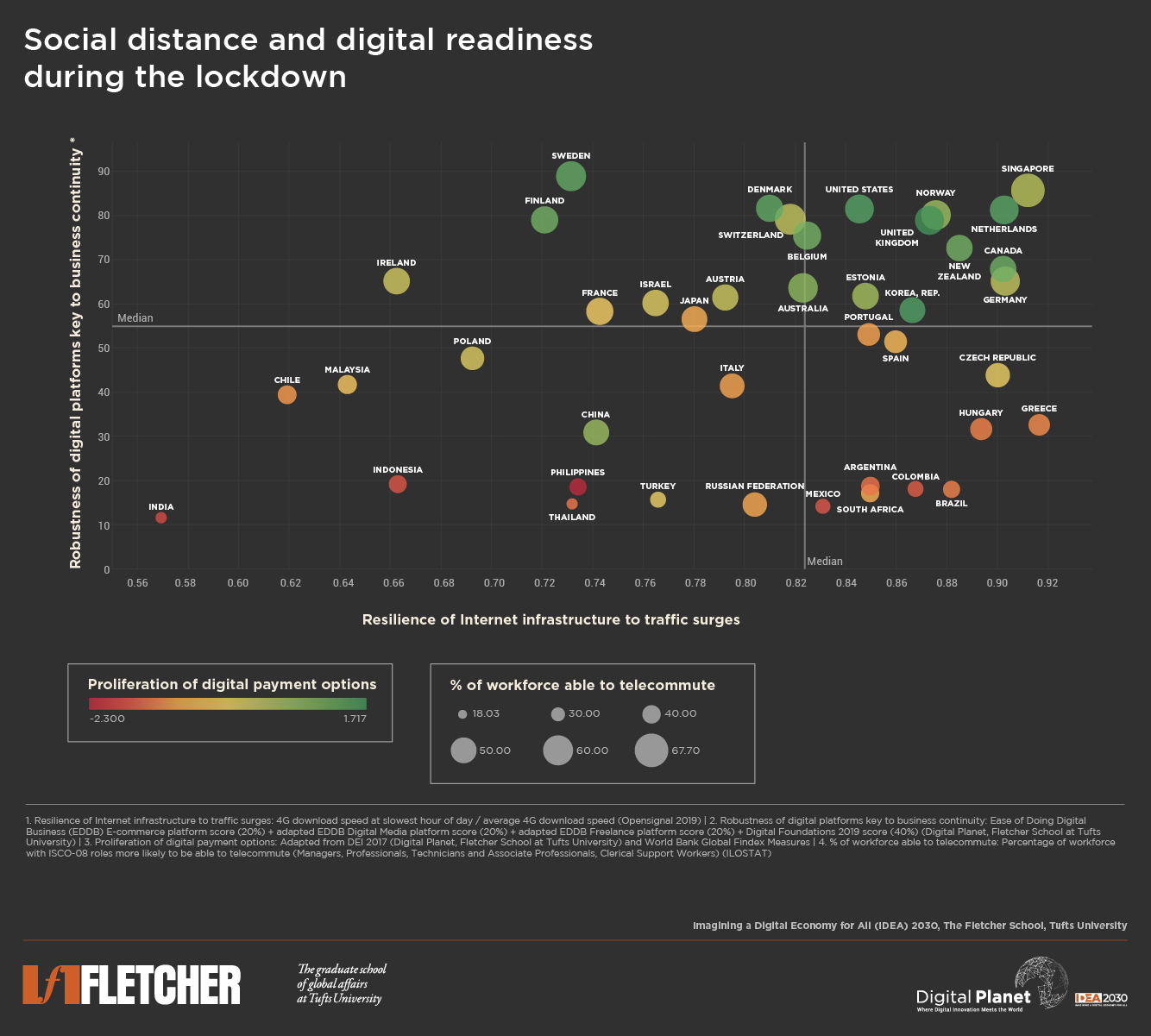Home > Off the Charts > Social Distance Readiness Benchmark
How Ready are Countries Around the World to Enter and Exit Lockdowns During COVID-19?
While only part of any economy’s work can be done remotely, the success of moving large swaths of work into “socially distant mode” depends on multiple digital services: telecommunications platforms and apps, e-commerce, and digital media to keep people informed and make good business decisions. On top of that, countries need digital payment options capable of handling the surges in transactions.
Key Observations and Insights
As the world races to contain the spread of COVID-19, socially distant modes of working has become the norm. Countries have mandated different measures and continue to update them. The range of measures suggests that policymakers are weighing a crucial trade off: economic costs of switching an economy to a socially distant mode using digital tools where possible, against the benefits of slowing the pandemic’s spread and flattening its curve. Without question, slowing the pandemic’s spread is the highest priority. As they pause the regular functioning of the economy, what policymakers and digital technology leaders must focus on are ways to reduce the economic costs by readying the country for socially distant working.
While only part of any economy’s work can be done remotely, we asked the question: how prepared are countries across the world to work in a “socially distant mode”? Digital Planet examined this question by evaluating 42 countries and the “social distance readiness” of their economies using three indices:
- Robustness of key platforms – technology-mediated remote work, e-commerce, digital media and the country’s digital foundations– key to business continuity
- Resilience of the Internet infrastructure to traffic surges
- Proliferation and resilience of digital payments options to facilitate transactions
At one end of the spectrum, Singapore and the Netherlands have emerged as standard-setters. Ironically, their path to social distancing has been more measured, despite being the best prepared. At the time of writing, the Netherlands government advises, “Leave the house only to go to work if you cannot work at home”. It had also experimented with a less aggressive approach to social distancing relative to its European neighbors, ostensibly to improve “herd immunity”. Singapore had not gone into a total lockdown and recently implemented it; only 40% of workers in the central business district worked from home at the end of March, a number likely to go up as penalties are being imposed for not allowing employees from doing so.
The US joins the group of advanced economies with a superior level of robustness of key digital platforms for business continuity and strong digital money proliferation. It has taken its time to institute social distancing guidelines, and businesses, particularly, those that deal in information are steadily asking employees to work from home. This will, no doubt, create stresses on the Internet infrastructure. As digital traffic surges, the US will feel the need to develop the levels of resilience of the very top performers, such as Singapore, the Netherlands, Canada and Germany. Internet traffic was up 18% on March 22 since the beginning of the year. In Seattle, it was even higher: up 25% since the beginning of the year. At the time of writing, across the US download speeds have held up well, but its experience varies. Mean download speeds over fixed broadband declined only slightly in the US, during the week of March 23 compared to the previous week, while it fell over mobile connections. The aggregate measures, however, hide a different reality — of extreme unevenness across the country. Recall, that the Internet is designed as a hierarchy of tiers – from the Tier 1 providers constituting the backbone to the last mile connections that get the data in and out of people’s homes. While surging traffic can be re-routed by the Tier 1 carriers or by content delivery services used by video carriers, such as Netflix and Google, to avoid congestion, there is no getting around the congestion in the last mile. The experience in that last mile can vary widely across the US.
Much of Europe, with some exceptions, suffers from middling robustness of the platforms and weak resilience of the Internet infrastructure. Speeds in much of Europe are much lower than in the US overall and the infrastructure is older. This means that high bandwidth using services that are less critical to economic productivity have to act urgently to reduce their traffic, as Netflix and YouTube already have committed to do so. This urgency is even greater in the southern EU nations; a particularly difficult case is that of Italy. As the graph shows, it is both less resilient and its platforms aren’t sufficiently robust, performing among the poorest of the European nations we studied.
Being proximate to the origins of the outbreak and with aggressive use of digital technologies, some Asian countries have taken a markedly different approach to the rest of the world. South Korea presents an interesting benchmark. Its Internet resilience is among the best in the world as is its use of digital payments and its platforms are robust even it doesn’t rank among the very highest. However, the country pioneered a location tracking app to gauge social distancing compliance and keeping people away from infected areas. In China, the starting point of the outbreak, readiness for socially distant work is much better than in most developing countries but it is not as robust or resilient as those in the north. However, once it started aggressively locking down key affected regions, China became a hotspot for the use of a cluster of digital technologies, including AI, location tracking, facial recognition, drones, etc. to contain the spread of the outbreak and enforce social distance compliance.
Unsurprisingly, developing world countries are the most vulnerable as measured by all three indices. That said, countries have taken somewhat paradoxical positions. There is a marked difference between the resilience of, say, India and Indonesia and, say, Mexico and Brazil. The latter pair demonstrate far greater resilience to traffic surges. Ironically, the government in both Mexico and Brazil have brushed aside the need for aggressive social distancing, while India is under lockdown and Indonesia has declared an emergency and is considering a lockdown. These positions are inconsistent and ought to be reconsidered keeping pre-emptive containment of COVID-19 as the primary concern.
Research Methodology
Digital Planet’s new analysis on Digital Readiness during COVID-19 offers quantitative insight to answer the question: which countries are the most prepared to keep the wheels of their digital economies turning during the COVID-19 crisis?
Our analysis maps 42 countries across two main axes: (1) Robustness of digital platforms key to business continuity and (2) Resilience of Internet infrastructure to traffic surges. We also examine the (3) Proliferation of digital payment options and (4) The percentage of workforce able to telecommute.
Index compilation methodology for scores follows the guidelines laid out by the OECD in their gold-standard Handbook on Constructing Composite Indicators. Weights for the indicators, clusters, and component hierarchy were assigned according to expert input under a budget allocation process (BAP).
A full breakdown of indicator inputs, data sources, and weights can be found here.









